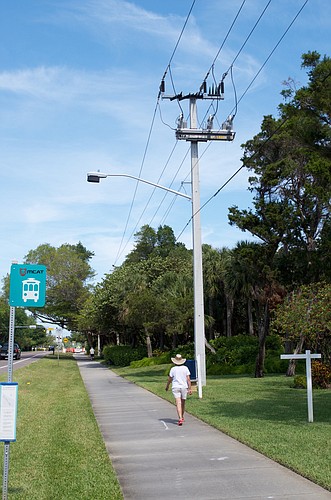- April 23, 2024
-
-
Loading

Loading

With decisions they’ll likely begin making next month, town commissioners will propel the town’s plan to build its own cellular network, balancing technical, aesthetic and financial needs while aiming to protect the town from the possibility of a duplicate network perhaps someday built alongside its own.
For years, Longboat Key has planned a coordinated project not only to do away with overhead transmission lines, but also to plug into the town’s need for upgraded cell service.
While the burying of cables is a relatively straight-forward, but massive, operation, the cell-service component remains a trickier needle to thread. At issue: federal regulations that prohibit local governments from “explicitly or implicitly” denying small-cell facilities built by private carriers in public right of ways.
Isaac Brownman, Longboat Key’s director of Public Works, said at a recent Town Commission meeting that the nation’s four top cell-service providers – Sprint, ATT, Verizon and T-Mobile – have offered positive feedback to the project contractor on the town’s plans and have expressed interest in using the town-built network once it’s completed, as early as 2022.
That’s not binding, though Town Manager Tom Harmer said the contractor is motivated also to ensure it can draw not only interest from the big four companies, but also their revenue.
On the flip side, there is nothing to stop a cell-service provider from deciding that building its own system from the ground up makes more sense than co-locating with the town’s system, opening the door for another set of poles and cell-transmission components built along the Gulf of Mexico Drive corridor even after the town’s network is in operation.
“So, while we might take action along the lines of recommending and encouraging them to use our facilities, bottom line is we cannot in any way preclude them putting in their own facilities,’’ Commissioner Jack Daly said.
That is why town leaders are carefully examining what they are allowed to regulate as the issues of pole height, spacing between poles, materials, appearance and more come before them. Federal regulations allow towns and communities to regulate aesthetics with a range of criteria, essentially allowing a measure of control.
“Those are all encouraging factors that the town does have the ability to regulate from the aesthetic side,’’ Brownman said.
By locking as many of those aesthetic variables as possible into the municipal code, the town hopes to eliminate any need for a second network to be built by making its own system more attractive to a provider simply by being in operation first. Town Attorney Maggie Mooney said the town is empowered to set design criteria and other factors. But, those have to be codified ahead of time, not simply applied when a carrier shows interest in building.
“Once we have a better vision for our community and what we want to see, it is very important that we build that into our code, so that if anybody else wants to come in, they have to meet our standards or co-locate on our poles,’’ she said.
And that’s what’s next for town leaders: coming up with those standards based on the realities of an islandwide radio frequency study, performed in March. Signal strength was analyzed with the goal of helping inform the design of the cell network – which will consist of poles (some with streetlights but many without) supporting transmitting and receiving gear linked to underground cables.
Commissioner Ken Schneier said from there it’s a matter of approving an ordinance “that defines what we want, including aesthetics, that threads a needle between being regulatory and being overburdensome/effectively prohibitory.’’
Demands from residents to “avoid the industrialization of our visual landscape’’ followed an early notion of poles as tall as 45 feet along Gulf of Mexico Drive and 35 feet tall in neighborhoods. Town officials dismissed such a possibility and sought study data that assumed poles of 35 or 25 feet on GMD; in the neighborhoods, 25 feet or 15 feet. Generally speaking, the taller the pole, the fewer of them required.
Brownman said that while the study’s final results are not in, “We did hear preliminarily that 15 feet is likely going to be a challenge regarding technical aspects and financial aspects.’’
Once the technical aspects of the radio frequency study is in, and the town commissioners begin making decisions on what size poles they want the town to use, network designers can come in and begin to assign places for all the poles as the design phase moves ahead.
But here’s that needle and thread part again. Approve a design with poles that appeal to the public notion of smaller poles create better aesthetics, and there’s a risk of the network’s performance not living up to cell carrier demands. Approve a design with optimum performance, and there’s a risk of public outcry.
“If we pick, let’s say we pick 25 feet for GMD for aesthetic reasons, and we don’t get really good input from the carriers, and they come back later and say ‘That’s not economical for us, we want 35 feet so it carries and we have less small-cell systems in place, so we’re going to put our own in,’ then shame on us if that happens,’’ Commissioner Mike Haycock said.